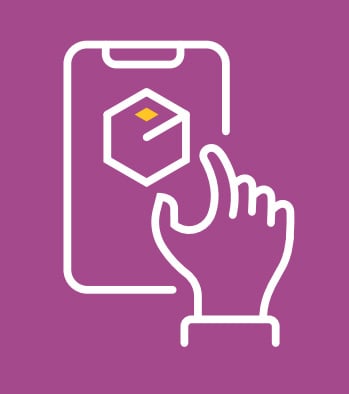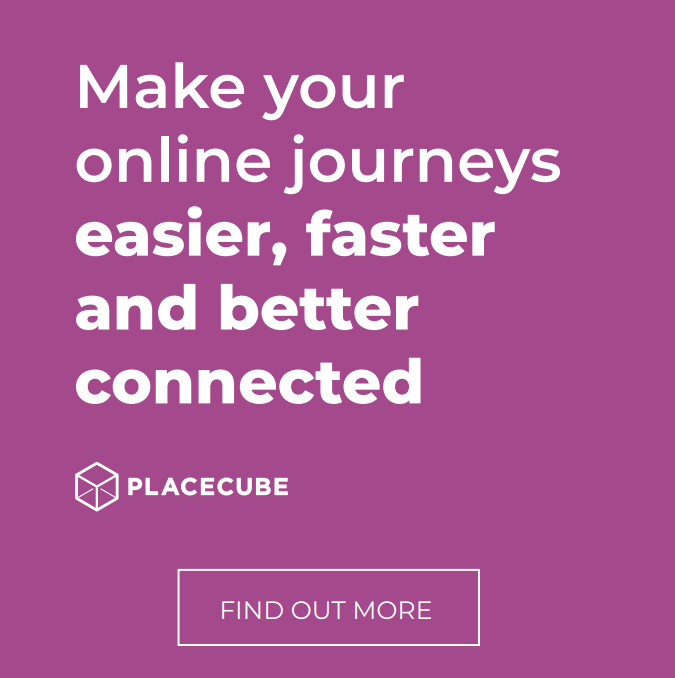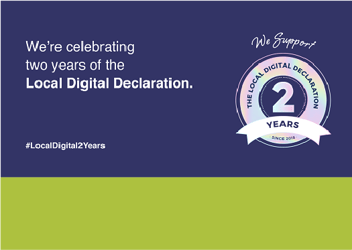Working with Huntingdonshire District Council on the MHCLG Local Digital funded 'SENA' project.
A couple of years ago Placecube began work to co-design and develop open standards based solutions to help people find community services. Working with Bristol City Council and the LGA as part of the DCMS funded Loneliness pilots we produced the first iteration of our Open Place Directory. And then as the MHCLG funded OpenCommunity project began to build support for adopting the OpenReferral standard, we got involved and worked with Porism and Buckinghamshire in a feasibility study that designed the proposed extensions that became OpenReferralUK and we implemented them in an update to Open Place Directory. All of our existing customers automatically gained access to this new standards support because of the way our open source based SaaS subscription works – so Blackburn with Darwen, Bristol, Elmbridge, Fylde Coast and North Lincolnshire are all able to publish ORUK compliant open services data feeds that work with any front-end service finder.
During the first wave of the COVID-19 pandemic we saw councils mobilise their whole workforces to ensure that the needs of communities and individuals were met as lockdown and rising infections suddenly created a whole new group of people who needed support. It was evident from the conversations we saw on social media and community support networks like LocalGov Digital and in KnowledgeHub that many councils needed a better understanding of community organisations and services – and that the councils who already had open standard and open source service directories were able to use them to get information into one place and help others to find it.
In this context, and with our commitment to support councils to meet the aspirations of the Local Digital Declaration, we were pleased to be selected to work with Huntingdonshire DC on the second phase of their “SENA” project. HDC had ambitions to go beyond the current models of working with community services organisations, to investigate how councils could work more effectively with citizens, to elicit data about their vulnerabilities, understand what services exist across the community, match those services with needs, and support a better feedback loop between councils and service providers – through an open set of digital, data and technology services.
We began working with HDC in late May 2021, mobilising a joint team, bringing together our User Researcher, a Service Designer from our long-term partners The Data Place, and our Product Manager and Technical Architect. We worked alongside business and data analysts from HDC, and service owners from their community services teams. It was a particular personal pleasure for me to work with Tony Evans (HDC’s Assistant Director of Transformation) and Sarah Goodall (HDC’s Delivery Manager) again, as we had shared experiences of working together back in 2014-16 in Bristol as part of our first forays into designing and building digital services.
The SENA project team also benefited from working with the team from the SAVVI project, another MHCLG funded collaboration focused on how standards and data interoperability can help with scaling public sector and community approaches to vulnerability. Placecube’s partners from Digital Gaps and Porism were supporting SAVVI, so we were able to work well together immediately, talking through ideas and developing understanding amongst the HDC team of the existing data standards, taxonomies of needs, circumstances and services and the relationships between them.
In Sprint 1 we worked to understand the outputs of SENA Phase 1, and who we needed to speak to in the various community organisations to gain a better understanding of how residents found services currently. Sprint 2 saw us run a number of user research sessions with people from the HDC community teams, and with the voluntary and community sector organisations providing services directly to people in need. We also began to sketch out an initial service blueprint, which would be iterated through the next two sprints, serving as a canvas to help capture all of the learning about the service and a way of communicating the emerging picture to everyone working on the project.

In Sprint 3 we built on the learning from our user research to sketch out some clickable wireframes and tested the reaction of some residents, to find out more about people’s willingness to provide information about themselves, and explored other aspects of the potential digital service like onward referrals to community service providers and whether a lightweight account would be useful.
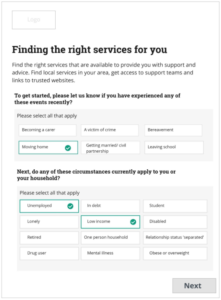
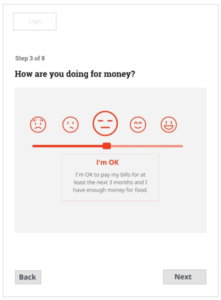
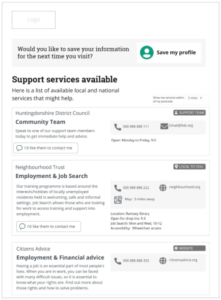
The output from this work informed an iteration of the Service Blueprint. The project team also connected with several other councils working on similar services, and learned from them. Throughout the first three sprints, our Product Manager and Technical Architect had been keeping in touch with the user research and emerging service design.
Towards the end of Sprint 3 and in Sprint 4 they began to develop a candidate technical architecture, and capture user stories in a backlog, with a number of reviews and iterations to improve the breadth and depth of the final products. The “service matching engine” component of our proposed technical architecture was defined through a collaborative workshop with the HDC data analysts working on the “needs and scoring model”. Our team was still reviewing and iterating the co-designed Service Blueprint even in this final sprint, so the technical architect, product manager and service designer all collaborated closely to ensure their products stayed in sync in the final days of the sprint.
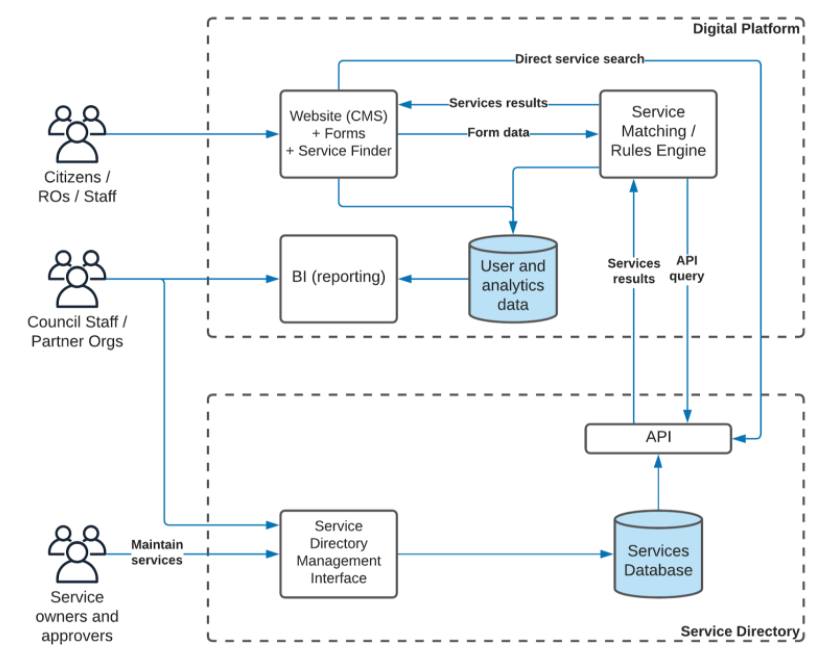
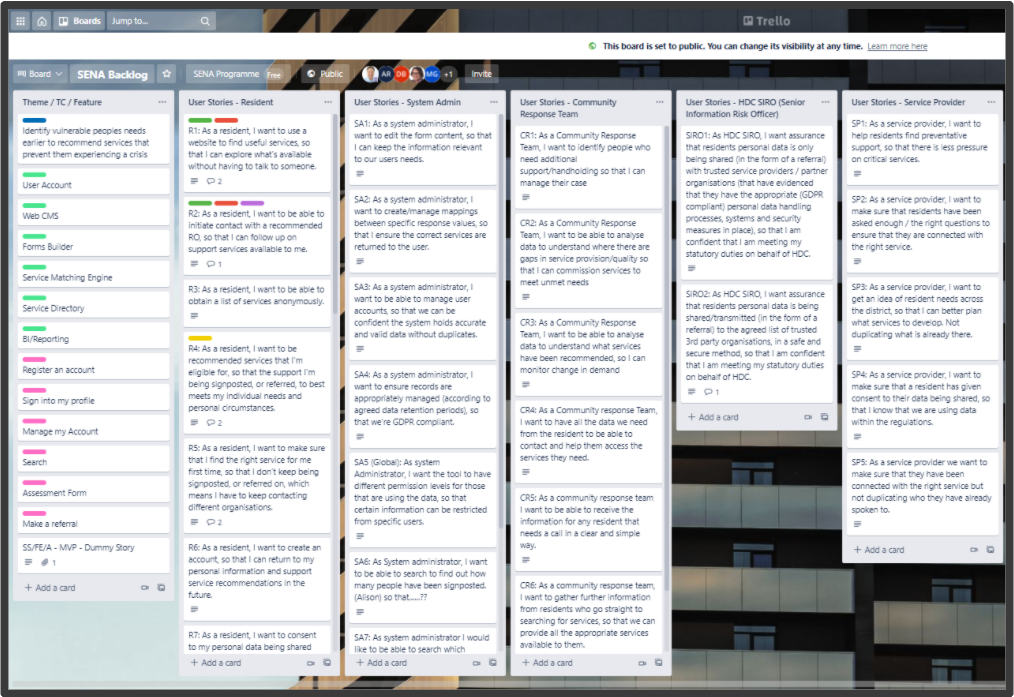
As we reflected in our end of project retrospective, we recognised as a project team that the compressed nature of a four sprint project meant that choices inevitably had to be made about breadth and depth of the work, and that given the complexity of the landscape we had achieved a good enough set of products that would enable a potential future project to take them on into further refinement and development. We are working with HDC to support the production of final project outputs, which will be openly available to any council or supplier who is interested in developing a solution. You can find all the project outputs on the Huntingdonshire Council projects website.
Of course we believe that our Digital Place for Local Public Services platform, alongside our Open Place Directory, offers a unique blend of openness and ease of reuse, which makes a strong case for using it to develop the proposed solution. We would publish the source code for the new service openly, and the nature of our platform means that any of our customers could adopt the new “cube” easily, as we push the service cube into their instance of the platform as part of their ongoing subscription. We are strong supporters of the great work done by service design and digital agencies for councils like Hackney, Buckinghamshire and others, that results in open source code on Github, but we also recognise the reality that over the past few years there has been almost no reuse of the Ruby and React apps that have been developed for those councils. We see the Digital Place model as one that respects the value of open source code, but removes the technical capability and capacity barriers that have prevented more widespread adoption amongst councils.
HDC are looking for councils who want to collaborate with them as partners on a proposal for Phase 3 of SENA, that would take the backlog, technical architecture and service blueprint from Phase 2, and use them to design, build and test the product.
If you’re interested in getting involved, talk to Tony Evans at HDC, or contact us
.png?width=1480&height=347&name=Placecube-Horizontal-BLK_4x%20(1).png)

